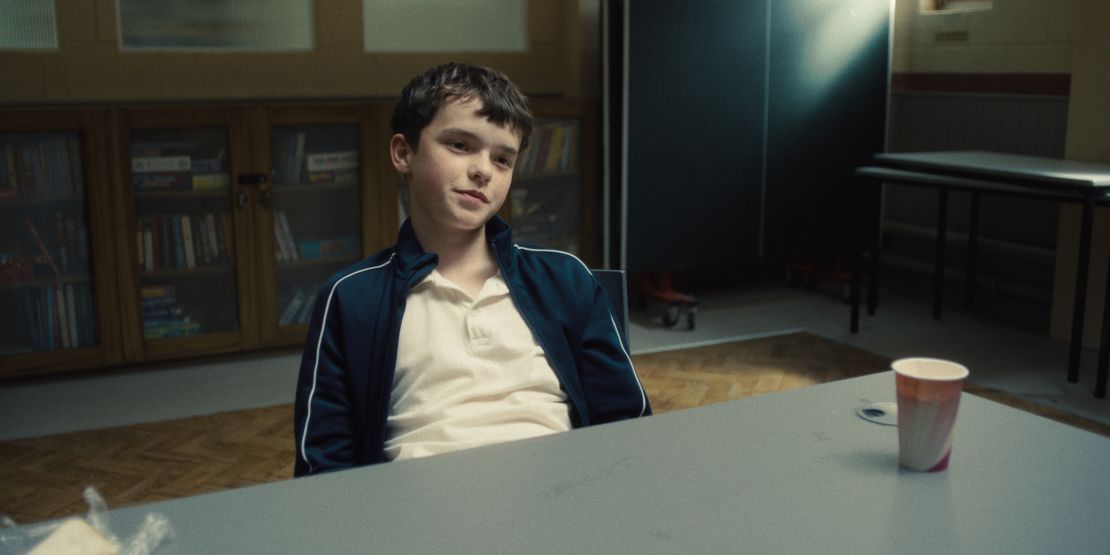CNN
—
The world for kids today looks a lot different than it did for their parents.
A scene from the hit Netflix series “Adolescence” captures just how vast that difference is.
In the show’s second episode, Detective Inspector Luke Bascombe (Ashley Walters) is at a secondary school to investigate why 13-year-old Jamie Miller (Owen Cooper), the central character, allegedly killed his classmate Katie. Based on their Instagram interactions, he assumes the two were friendly, if not romantic.
That is, until Bascombe’s son — also a student at the school — tells him he’s got it all wrong.
The seemingly innocuous emojis that Katie commented with on Jamie’s Instagram were actually a coded form of bullying. The dynamite emoji represents an exploding red pill, a reference to the manosphere. The 100 symbol is another manosphere nod, alluding to a theory in those circles that 80% of women are attracted to 20% of men.
In other words, Katie implied that Jamie is an incel.
It’s a dizzying realization for Bascombe and the other adults — who are clearly clueless about the pernicious ideas that kids in their care are exposed to and how that permeates their lives.
That disconnect is at the heart of “Adolescence,” which since its premiere has viewers talking about young men’s attitudes toward women, incel culture, smartphone use and more.
The British miniseries starts out as a crime drama, but over the course of its four episodes, it explores what exactly could have possessed such an innocent-looking boy to do something so horrific.
The answers it comes up with aren’t so simple.
CNN spoke to series co-creator Jack Thorne about his journey into darker corners of the internet, young male rage and what he hopes parents take away from the show.
The conversation has been edited for length and clarity.
This series touches on a lot of timely issues: The manosphere, modern masculinity, online bullying. What made you want to tell this story?
It started with my friend (series co-creator) Stephen Graham. Stephen called me up and said we should write a show about boys hating girls and about knife crime, which in (the UK) is really problematic right now.
That was the start of us talking about male rage, our own anger, our own cruelty. We were trying to build a complicated portrait of masculinity: Of how we were made and how teenagers are being made in a lot of similar ways, but with a lot of differences, too.
Were these issues something you had been thinking about for a while?
It’s something I’ve been thinking about, but something I’d sort of dismissed.
As I was leaning in and trying to understand, I actually found a lot of things that were surprising to me, and a lot of ideas that, if I’d heard them at the wrong time, would have taken me on journeys that I’m very grateful I didn’t go on.
The ideas behind incel culture are very attractive because they make sense of a lot of things: feelings of isolation, low self worth, feeling unattractive. They tell you that there is a reason why the world is against you: Because the world has been built from a female perspective, and these women have all the power. (These ideas suggest that) you need to better yourself, get in the gym, learn how to manipulate and learn how to harm.

What was your research process for writing the character of Jamie?
Looking in a lot of dark corners, so Reddit and 4chan, and then changing my algorithm. I had a lot of burner accounts on all the big social media platforms, and I started following the obvious people. The obvious people took me to the less obvious people, and the less obvious people were the ones that I found really interesting.
No 13-year-old really is consuming Andrew Tate. What they are consuming is someone that’s really into gaming or TV shows or music, who has consumed Andrew Tate and is now espousing it in a different way. That level of the waterfall was the level I concentrated on as I was trying to find the people that had helped build Jamie.
Was there an overarching question that you were trying to answer?
Why did Jamie do it?
We always said, “This isn’t a whodunnit, but a whydunnit.” That’s why we go to the school in episode two, because if we hadn’t seen the education system, we wouldn’t have understood him properly. If we hadn’t seen the way that his peers operate, we wouldn’t have understood him properly. In episode three, we’re trying to understand the way that his brain works and what he’s processed.
Then in episode four, we’re in almost the most complicated place. We’re not going to make it easy to blame the parents for everything, but they are partially responsible here. What do they do with that question of responsibility, and how much responsibility should they take?
You explored Jamie’s descent into violent misogyny from multiple perspectives: His school environment, his home environment, his social media use. Where did he go wrong?
There’s that phrase, “it takes a village to raise a child.” It also takes a village to destroy a child, and Jamie has been destroyed.
He’s being destroyed by a school system that’s not helping him. He’s been destroyed by parents that are not really seeing him. He’s been destroyed by friends that maybe don’t reach him in the way that he needs to be reached. He’s been destroyed by his own brain chemistry, and he’s been destroyed by the ideas that he’s consumed. All these different elements are in play here.

I know you have a young son. How are you navigating these issues as a parent?
We’re not quite there yet. He’s just coming up to 9, and he likes “The Gremlins” and Roald Dahl. He’s not quite in the position where he’s interested in phones, and he’s certainly not interested in vlogs or blogs or any of those things.
The question is what we do when the pressure starts to build. What happens when he goes to secondary school and 80% of his class have got smartphones and he wants one, too? (What happens) when they get to take their phone to bed, and he wants to take his phone to bed, too?
That stuff is terrifying to me. Trying to work out group solutions to it is probably the answer, rather than trying to govern it from parent to parent. So that’s creating discussion groups amongst the parents, so that hopefully when we get to 11, enough of his friendship group have been denied phones that us denying him a phone is not as awful as it otherwise might be.
What needs to change to address the radicalization of young men?
I think we need to find a way of dealing with social media. How we do that with the people that are governing social media right now is very tough, because it’s not going to come from (the platforms) policing themselves. And in America, it’s not going to come from legislation either.
In Britain, we’re trying to talk to the government about the digital age of consent. In Australia, under 16 are banned from social media, and it’s the social media companies’ responsibility to keep them off it. I hope that in Britain we can start talking about it. But how you do that in America right now, I do not know.
This morning, I read about a parent group in Kent (a county in England) who are all working together to stop their kids at that crucial age getting smartphones. That will be huge, but it’s a very, very complicated problem. And it requires a lot of complicated solutions.
Each episode of the series was filmed as one continuous shot, which was a fascinating creative choice. How did that affect the way you told the story?
It wasn’t my decision. That was what (director Phil Barantini) and (Graham) took to me when I first got involved, and I was really excited by it. The reason why I love it from a writing perspective is it encourages you to think in a whole different way.
(Graham) said there’s one rule with writing single-shot shows, which is that the camera can’t go anywhere without a human. So you had to find a way of spinning enough stories to keep the audience’s attention. We couldn’t just stay with Jamie, and we couldn’t just stay with Eddie (Jamie’s father, played by Graham). We had to be moving inside that police station. We had to find different, other stories to follow.
It also forced me to be really partial in my storytelling. Usually your job as a storyteller is to give as much information to the audience as possible. You would be cutting to Katie’s family. You would be cutting to Jamie going through the legal process. You’d be cutting to Bascombe dealing with the problem of the missing knife. I can’t suddenly move in time and place too rapidly.
It shakes an audience out of its normal consumption method. It’s forced them out of their comfort zone a little bit and made them uneasy, and that was to our benefit.
I found that scene from episode two, in which DI Bascombe’s son explains the hidden meaning of those emojis, so striking. What do you think that exchange captures about the gulf between parents and children today?
It’s one of my favorite scenes because it’s about two things: It’s about him unpeeling something that he doesn’t understand and being bewildered by what he’s trying to understand. And it’s about a really delicate relationship between father and son that’s quite seriously broken.
In that scene, he recognizes for the first time that he is Eddie in this situation — he hasn’t seen his kid, and he doesn’t understand so much of what his kid is experiencing.
There’s not many moments of positivity in this show, but the gentle love story between Bascombe and his son, ending with them going off to get chips together, is one of the sweeter stories that we tell in the whole show.

Have you heard from other parents who have watched the show?
It’s been amazing. The really gratifying thing has been parents who’ve watched this show with their kids. Even (UK Prime Minister Keir Starmer) actually talked about watching the show with his 16-year-old and 14-year-old.
Close friends have said, “You’ve prompted discussions with me and my kids that I’ve never had before.” That’s the best review you could possibly get.
You’ve previously described TV as an “empathy box.” What do you hope that viewers take away from the show?
Listen to kids. They’re really vulnerable right now, and they need you.
That’s everyone. That’s not just parents, listen to your children. That’s teachers, listen to your students. That’s politicians, listen to the young people. I think they’re the great excluded at the moment, and I think they’re going through enormous pain. And we need to help them, because they’re in real trouble.
There aren’t simple answers to this, but the biggest answer is let them talk, or find a way to get them talking, or get inside what they’re worrying about. Then maybe, maybe you can release some stuff that can allow you to help them.

